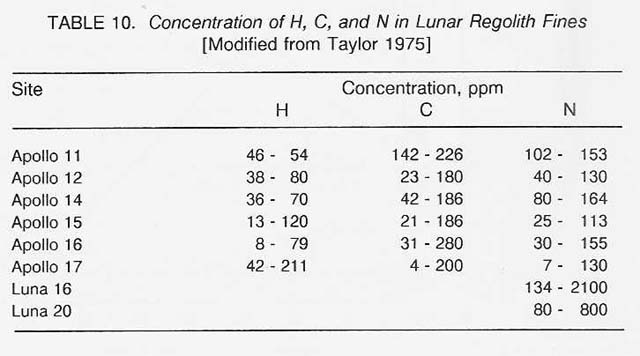
Minerals: The constant meteoritic and cometary bombardment of the lunar surface
results in comminution of whole rocks, with liberation of the mineral constituents.
Most of the minerals listed in table 7 have been found as isolated grains or
as composite particles in the lunar regolith fines. The available anorthite
content in the Apollo 16 lunar highland regolith samples (90- to 150- micrometer
size fraction) varies from just under 17 percent to just over 82 percent (see
table 8) and averages 43.5 percent. The lower values result from the inverse
relationship between available anorthite content and agglutinate content (see
figure 5). The ilmenite content of mare basalts from all Apollo missions varies
from 0.5 percent to 37 percent (see table 9) and averages 11.5 percent. If the significantly lower Apollo 15 samples are omitted, the
average is 14.4 percent. Electrostatic separation experiments in vacuum by Agosto
(1985) suggest that grade and recovery percentages should be between the high
70s and the low 90s.

Glasses: There are two main types of glasses found in the lunar regolith - homogeneous and heterogeneous (Taylor 1975). The homogeneous glasses are "volcanic" in origin or produced by major impacts, and the heterogeneous glasses are produced by more minor impacts. Two chemically distinct homogeneous glasses have been found to be abundant in spots: green and orange (Taylor 1975). The green glasses are of the most primitive lunar composition yet found and are a possible source of aluminum. The orange glasses are a possible source of titanium. In addition, both have surface coatings that may offer chlorine, copper, lead, zinc, and other volatile elements and compounds (Jovanovic and Reed 1973, Rhodes 1973, Chou et al. 1975, Meyer et al. 1975). However, in order to utilize this material, we would have to undertake extensive chemical processing. The heterogeneous glasses have a wide range of chemistries (Taylor 1975), and thus it would be difficult to separate them from the rest of the regolith.
Volatile species: Because the Moon has no atmosphere, the lunar regolith fines are a potential source of solar-wind-implanted ions such as H, N, C (table 10; see also, for example, Eberhardt et al. 1972 anqj Gibson, Bustin, and McKay 1988), and 3He. Wittenberg, Santarius, and Kulcinski (1986) calculated that the Moon's surface materials contain approximately 109 kg of 3He. If 3He can be developed as an energy source, the energy payback for extracting and transporting 3He to Earth is approximately 250, which is better than 1 0 times the payback for conventional energy sources on Earth.

|
Curator: Al Globus If you find any errors on this page contact Al Globus. |
 |
This site was hosted by the NASA Ames Research Center from 1994-2018 and is now hosted by:
